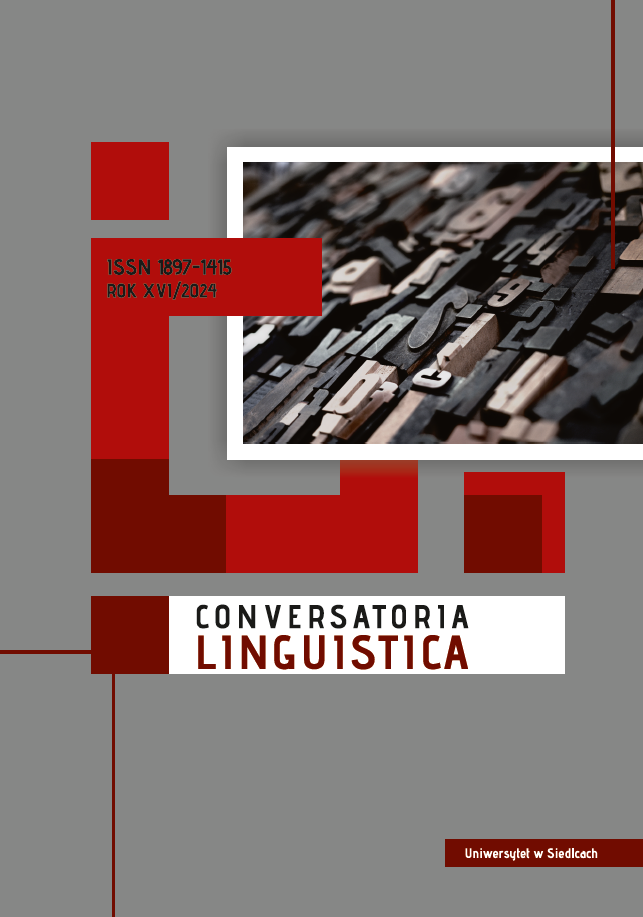Natural Semantic Metalanguage as a Tool for Mediating Communication in Language Teaching and Learning
DOI:
https://doi.org/10.34739/clg.2024.16.01Keywords:
natural semantic metalanguage (NSM), Common Eurepean Framework of Reference (CEFR), language teaching and learning, mediation, greetingsAbstract
In this paper we seek to implement the natural semantic metalanguage (NSM) approach as a tool for mediating communication in foreign language classroom. Mediation is an important term introduced to language teaching and learning in the Common European Framework of Reference (CEFR2001) and developed in CEFR. Companion Volume (2020). It refers to one of the four modes of communication (reception, production, interaction and mediation) – in which social dimension of language is put forward, and the language user is viewed as a social agent. Language per se is an important mediating tool, a mini-language curved out of any human language is even stronger facilitator of meaning explication. It can be useful both in constructing and co-constructing new meaning, and in passing on information, especially in multicultural contexts. Being free from ethnocentric bias, NSM can provide a clear and effective strategy to deal with “otherness” and to create a neutral, safe communication space. To illustrate its efficacy, we will give some examples, explaining via NSM how deceptively similar concepts, such as names for time of day, especially the ones used in greetings, vary between Spanish, English and Polish language.
Downloads
References
Literature
Agar M. (1994): Language Shock. Understanding the Culture of Conversation, New York.
Council of Europe (1998): Threshold 1990, Cambridge, URL: https://www.ealta.eu.org/ documents/resources/Threshold-Level_CUP.pdf.
Council of Europe (2001): Common European Framework of Reference for Languages: Learning, Teaching, Assessment, Cambridge. URL: https://rm.coe.int/1680459f97.
Council of Europe (2020): Common European Framework of Reference for Languages: Learning, Teaching, Assessment. Companion Volume, Strasbourg. URL: https://rm.coe. int/common-european-framework-of-reference-for-languages-learning-teaching/ 16809ea0d4.
Ek J. van (1975): Systems development in adult language learning. The threshold level in a European unit/credit system for modern language learning by adults. Strasbourg. URL: https://open.books4languages.com/project/wp-content/uploads/si-tes/23/2017/01/The_Threshold_Level_in_a_European_UnitCredit_system_for_mo-dern_language_learning_by_adults.pdf.
Farese G.M. (2015): Hi vs. Ciao: NSM as a tool for cross-linguistic pragmatics, “Journal of Pragmatics”, no 85, p. 1–17.
Farese G.M. (2018): The Cultural Semantics of Address Practices, Lanham.
Fernández S. (2016): Possible contributions of Ethnopragmatics to second language learning and teaching, in: Let us have articles betwixt us –Papers in Historical and Comparative Linguistics in Honour of Johanna L. Wood, eds. S. Vikner, H. Jørgensen & E. van Gelderen, Aarhus University, p. 185–206.
Goddard C. (2010): Semantic molecules and semantic complexity (with special reference to “environmental” molecules), “Review of Cognitive Linguistics”, no 8(1), p. 123–155.
Goddard C. (2018): Ten Lectures on Natural Semantic Metalanguage, Leiden.
Goddard C., Wierzbicka A. (2007): Semantic primes and cultural scripts in language learning and intercultural communication, in: Applied Cultural Linguistics: Implications for Second Language Learning and Intercultural Communication, eds. G. Palmer, F. Sharifian, Amsterdam, p. 105–124.
Goddard C., Wierzbicka A. (2014): Words and Meanings. Lexical Semantics Across Dom-ins, Languages, and Cultures, Oxford.
Grucza F. (1991): Terminologia. Jej przedmiot, status i znaczenie, w: Teoretyczne podstawy terminologii, ed. Franciszek Grucza, Wrocław, p. 11–44.
Martyniuk W. (2021): ESOKJ 2020: nowy, zmodernizowany europejski system opisu kształcenia językowego, ”Postscriptum Polonistyczne”, no 28(2), p. 1–18.
North B. (2016): Developing CEFR illustrative descriptors of aspects of mediation, “Inter-national Online Journal of Education and Teaching (IOJET)”, no 3(2), p. 132–140. URL: http://iojet.org/index.php/IOJET/article/view/125/131.
North B., Piccardo E. (2016): Developing illustrative descriptors of aspects of mediation for the Common European Framework of Reference (CEFR), Strasbourg.
Piccardo E., North B., Goodier T. (2019): Broadening the Scope of Language Education: Mediation, Plurilingualism, and Collaborative Learning: the CEFR Companion Volume. “Journal of e-Learning and Knowledge Society”, no 15(1), p. 17–36.
Sadow L., Fernández S. (2022): Pedagogical pragmatics: natural semantic metalanguage applications to language learning and teaching, “Scandinavian Studies in Language”, no 13(1), p. 53–66.
Trim J.L.M (1975): Foreword, [in:] Threshold Level English, ed. J. van Ek, Oxford, p. 102– –104. URL: https://rm.coe.int/threshold-level-series-prefaces-introductions-serie-nive-aux-seuils-pre/168077c54b.
Wierzbicka A. (1991): Cross-Cultural Pragmatics, Berlin.
Wierzbicka A. (1996): Semantics: Primes and Universals, Oxford.
Wierzbicka A. (2013): Imprisoned in English. The Hazards of English as a Default Language, Oxford.
Internet sources
Goddard C. (2021): The Molecules Project (a conference presentation given at NSM-Con21 on 15th April 2021), 9 VII 2024.
Longman Dictionary of Contemporary English, https://www.ldoceonline.com/about.html, 9 VII 2024.
Marcjanik M. (2006): Dzień dobry czy dobry wieczór?, SJP PWN, https://sjp.pwn.pl/ poradnia/haslo/Dzien-dobry-czy-Dobry-wieczor;6906.html, 9 VII 2024.
What is NSM?, https://intranet.secure.griffith.edu.au/schools-departments/natural-se-mantic-metalanguage/what-is-nsm, 9 VII 2024.
Downloads
Published
Issue
Section
License
Copyright (c) 2024 Conversatoria Linguistica

This work is licensed under a Creative Commons Attribution-NonCommercial 4.0 International License.




